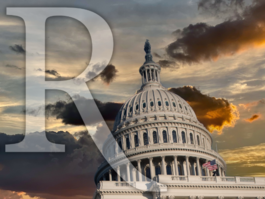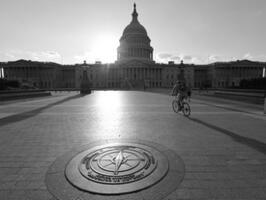Does Supreme Court Limit Big Government Enough?
Ratings for the U.S. Supreme Court are more positive than they’ve been in over two years, although one-third of voters still don't think the high court puts the brakes on the federal government enough.
A new Rasmussen Reports national telephone survey finds that just 32% of Likely U.S. Voters think the nation's highest court does a good or excellent job. That’s up from 28% in November and is the highest positive rating since December 2012. Twenty-two percent (22%) rate its performance as poor, the lowest finding since late 2012. (To see survey question wording, click here.)
Prior to 2013, positives for the court generally remained in the low to mid-30s since 2011. The last time good or excellent marks for the high court were above 40% was in October 2009. Poor marks for the court hit a high of 30% in June 2013 following controversial rulings on voting rights, affirmative action and same-sex marriage.
Thirty-one percent (31%) say the Supreme Court does not put enough limitations on what the government can do. This finding is down five points from last June but is still higher than the 27% who felt this way in September 2013. Just 14% say it puts too many limitations on government instead. Thirty-eight percent (38%) says the balance is about right. Seventeen percent (17%) are not sure.
President Obama’s immigration plan and his national health care law both face legal challenges this year that could bring them to a halt in the Supreme Court. But one-in-four voters think the president should be able to ignore the courts if he wants to, and Democrats believe that even more strongly.
Twenty-eight percent (28%) of voters choose the Supreme Court as the branch of government they trust most, up two points from the previous survey. The court is nearly even with the president who is trusted most by 29%. Twenty-one percent (21%) trust Congress the most, up five points from last year. Another 22% aren’t sure.
However, only five percent (5%) rate the executive branch the most important of the three branches of our government, while just as many (6%) feel that way about the judiciary. Thirteen percent (13%) consider the legislative branch the most important. But an overwhelming 74% view all three branches to be of equal importance.
(Want a free daily e-mail update? If it's in the news, it's in our polls). Rasmussen Reports updates are also available on Twitter or Facebook.
The national telephone survey of 800 Likely Voters was conducted by Rasmussen Reports on February 22-23, 2015. The margin of sampling error for the survey is +/- 3.5 percentage points with a 95% level of confidence. Fieldwork for all Rasmussen Reports surveys is conducted by Pulse Opinion Research, LLC. See methodology.
Just 12% of voters believe the actions of the U.S. government today represent the desires of most Americans. Only 19% trust the federal government to do the right thing all or most of the time.
Thirty-two percent (32%) of voters consider the Supreme Court too liberal. Twenty-five percent (25%) think it's too conservative. Thirty-one percent (31%) say, in political terms, the high court is about right ideologically. Voters have long tended to view the court as too liberal, but the number who consider it too conservative had increased over the past year. The latest finding of those who see the court as too conservative, however, is the lowest since June 2013.
Most voters (55%) still think most Supreme Court justices have their own political agenda, but that's down from last June’s high of 61%. Twenty-eight percent (28%) disagree and think the justices generally remain impartial. Seventeen percent (17%) are not sure.
Republicans and Democrats give the Supreme Court similar reviews, but those not affiliated with either major political party are slightly more critical. But while most Republicans (55%) regard the court as too liberal, a plurality (43%) of Democrats thinks it is too conservative. Unaffiliated voters tend to think the court is about right ideologically speaking.
Forty-three percent (43%) of Republicans believe the Supreme Court does not put enough limitations on the government, while 46% of Democrats think the limits it imposes are about right. Unaffiliated voters are evenly divided between those two opinions. Only 11% of GOP and unaffiliated voters think the high court limits the government too much, compared to 19% of the voters in the president's party.
Voters under 40 give the Supreme Court more positive ratings than their elders do. Older voters tend to feel more strongly that the justices are too liberal.
Voters give much better reviews to the Supreme Court than they do Congress, though the latter’s ratings have gone up in recent weeks. Voters remain almost evenly divided when it comes to the job the president is doing, although those who Strongly Disapprove continue to outnumber those who Strongly Approve.
Forty-one percent (41%) of Americans think the Supreme Court is too hostile toward religion, and half believe rulings by judges in recent years have been more anti-religious than the Founding Fathers intended.
A year ago, just 42% said the United States has the best system of justice in the world. Perhaps in part that’s because only 33% of U.S. voters believe most judges in their rulings follow the letter of the law.
Additional information from this survey and a full demographic breakdown are available to Platinum Members only.
Please sign up for the Rasmussen Reports daily e-mail update (it's free) or follow us on Twitter or Facebook. Let us keep you up to date with the latest public opinion news.
The national telephone survey of 800 Likely Voters was conducted by Rasmussen Reports on February 22-23, 2015. The margin of sampling error for the survey is +/- 3.5 percentage points with a 95% level of confidence. Fieldwork for all Rasmussen Reports surveys is conducted by Pulse Opinion Research, LLC. See methodology.
Rasmussen Reports is a media company specializing in the collection, publication and distribution of public opinion information.
We conduct public opinion polls on a variety of topics to inform our audience on events in the news and other topics of interest. To ensure editorial control and independence, we pay for the polls ourselves and generate revenue through the sale of subscriptions, sponsorships, and advertising. Nightly polling on politics, business and lifestyle topics provides the content to update the Rasmussen Reports web site many times each day. If it's in the news, it's in our polls. Additionally, the data drives a daily update newsletter and various media outlets across the country.
Some information, including the Rasmussen Reports daily Presidential Tracking Poll and commentaries are available for free to the general public. Subscriptions are available for $4.95 a month or 34.95 a year that provide subscribers with exclusive access to more than 20 stories per week on upcoming elections, consumer confidence, and issues that affect us all. For those who are really into the numbers, Platinum Members can review demographic crosstabs and a full history of our data.
To learn more about our methodology, click here.





